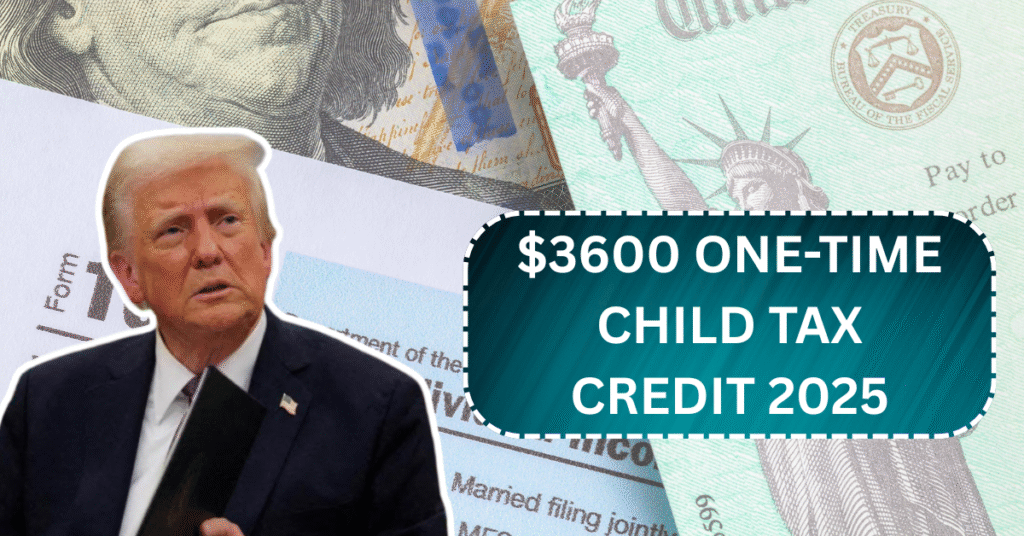The $3600 one-time child tax credit (CTC) is one of the most discussed financial aids introduced in 2025, providing crucial support to families. If you’re a taxpayer with children, this credit could significantly impact your finances. Understanding the eligibility criteria, payment dates, and the process for claiming the credit is essential to ensure you don’t miss out on this benefit. In this article, we’ll break down everything you need to know about the $3600 CTC, from its qualifications to when you can expect the payment.
What is the $3600 One-Time Child Tax Credit (CTC)?
The $3600 One-Time Child Tax Credit is a special tax relief initiative announced by the government for the year 2025. This credit offers families a direct payment of up to $3600 for each qualifying child under the age of 18. The amount is paid in one lump sum, unlike the monthly installments that were part of previous stimulus packages. It’s designed to help parents and guardians with the increased costs of raising children, providing financial relief to households across the country.
Eligibility for the $3600 Child Tax Credit
Not all families will automatically qualify for the full amount. To benefit from the $3600 credit, there are specific eligibility requirements. Let’s take a look at who qualifies:
- Age of the Child:
The child must be under the age of 18 at the end of 2025. This means children born after December 31, 2007, will qualify for the tax credit. However, children who turn 18 before the end of 2025 won’t be eligible. - Tax Filing Status:
You need to be a U.S. citizen or resident, and your filing status must meet certain conditions. Generally, families who file their taxes as “Head of Household,” “Married Filing Jointly,” or “Single” will qualify. However, families who file as “Married Filing Separately” may face restrictions. - Income Limits:
One of the most important criteria is your income level. The full $3600 will be available to those with an income below certain thresholds:- For single filers, the credit phases out for those earning above $75,000.
- For head of household filers, it phases out for those earning above $112,500.
- For married couples filing jointly, the phase-out threshold is $150,000.
- Child Residency Requirements:
The child must have lived with you for at least half the year in 2025. This means if your child lived with someone else for the majority of the year, you might not qualify for the credit. - Social Security Number (SSN):
To qualify, the child must have a valid SSN or an Individual Taxpayer Identification Number (ITIN). Without proper documentation, you won’t be able to claim the credit.
How Much Will You Receive?
The credit amount per child depends on your household’s income and the number of eligible children. For the year 2025:
- The maximum credit is $3600 per child for children under 6 years old.
- For children aged 6 to 17, the credit is reduced to $3000 per child.
It’s also important to note that the credit is fully refundable, meaning that if your tax liability is lower than the credit amount, you may still receive the difference as a refund.
When Will You Receive the $3600 Child Tax Credit?
The $3600 One-Time Child Tax Credit will be distributed in a lump sum. The government has set specific dates for when families can expect to receive their payments. The schedule for the 2025 payments is as follows:
- Direct Deposit: Families who have provided their bank account information for direct deposit will receive their payments in early July 2025.
- Paper Checks: If you haven’t provided direct deposit information, you will receive your payment as a paper check, which may take a few weeks longer to arrive.
- Payment Schedule: The payment will be made in one lump sum and is expected to reach most families by mid-July. However, the exact dates may vary based on your tax filing and whether you file for an extension.
If you qualify for the credit but do not receive your payment by the scheduled date, make sure to check with the IRS or your tax preparer to ensure your payment details are correct.
How to Claim the $3600 One-Time Child Tax Credit?
Claiming the $3600 CTC is relatively straightforward if you have filed your taxes and meet the eligibility requirements. Here’s how you can claim it:
- File Your Taxes: The first step is to file your 2025 tax return. Ensure that you include all your dependents and their correct Social Security Numbers (SSNs). This will allow the IRS to calculate your eligibility and ensure that the correct credit is applied to your account.
- Check Your Bank Details: If you’re eligible for the direct deposit option, make sure your bank account details are up-to-date. This will help ensure that you receive the payment quickly and without delays.
- Use the IRS Child Tax Credit Portal: If you have not yet filed your taxes for 2025, you can use the IRS portal to verify your eligibility, provide your bank account information for direct deposit, and track your payment status.
- Check Your Payment Status: Once your return is processed, you can check your payment status using the IRS website or through their online tools. This can help you know when to expect your payment.
Frequently Asked Questions (FAQs)
Q1: Can I claim the $3600 child tax credit if I am not filing taxes?
If you do not usually file taxes, you can still apply for the credit by using the IRS portal to submit your information. Make sure you meet all the eligibility requirements, including income thresholds.
Q2: What happens if my income exceeds the limit for the full credit?
If your income is above the limit, you may still receive a partial credit. However, the amount will decrease as your income rises above the thresholds.
Q3: Will the $3600 be subject to tax?
No, the $3600 child tax credit is not taxable. It is a tax refund, which means it won’t be included in your taxable income for 2025.
Conclusion
The $3600 One-Time Child Tax Credit is a vital financial support for families with children in 2025. By understanding the eligibility requirements, payment schedule, and process for claiming the credit, you can ensure that you receive the full amount you’re entitled to. As always, stay in touch with the IRS and your tax professional to keep track of any updates and ensure a smooth filing process.




